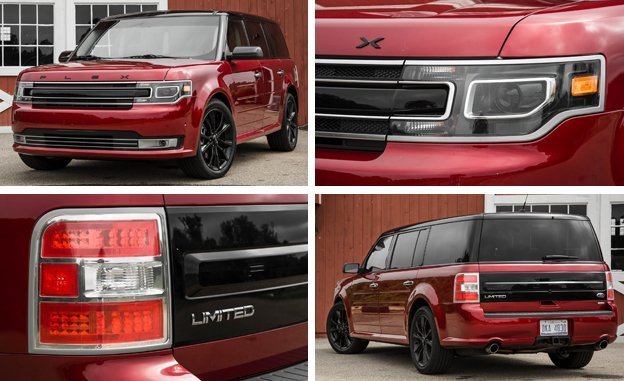It seems like only yesterday that we first extolled the cool-parent virtues of the Ford Flex, but the wagon/crossover box-of-all-trades hit the market as a 2009 model. Neither a high-riding wannabe SUV nor a traditional car-height station wagon, the Flex still offers distinctive, unabashedly squared-off style and a useful, reconfigurable three-row cabin. We like it, and always have, but Ford doesn’t sell many of them, and the model’s future is uncertain. With its days potentially numbered, we thought it wise to check back in on our favorite pseudo wagon while we had the chance.
Eight years after first going on sale, the Flex is still funky, but it posts the smallest sales numbers in Ford’s lineup. The Explorer, which shares the Flex’s underpinnings and packages the three-row seating format and similar size into the more popular crossover mold, outsold it more than nine to one over the past three years. Another platform-mate, the wallflower Taurus sedan, outsold the Flex by nearly three to one during the same period. Most people look at the Flex and probably think, rightly so, that it’s some sort of retro-modern take on the all-American station wagons that roamed the interstates like invading ant colonies in the 1960s and 1970s. That’s precisely why we dig it—that and the available 365-hp, twin-turbocharged V-6 EcoBoost engine. It should come as no surprise that for this retrospective test we chose to sample the Flex Limited, the only way to get the meaty V-6 (a 287-hp 3.5-liter naturally aspirated V-6 also is available in the Flex).
Middle Age Was Ages Ago
While the Flex’s positive attributes haven’t changed since it was introduced in 2008 (and only improved with its updates for 2013), the competition has moved on, and this Ford is starting to show its age. The inner door panels are mostly hard plastic, onto which soft-touch pads are added; the same plastic is used for the top of the dashboard, and it is used more widely the farther rearward one moves in the cabin. Plop down in one of the third-row seats, and you’ll be surrounded by the stuff. It’s even easier to take a paleontological approach to date the Flex’s interior by studying its various buttons and switches; the steering-wheel controls, for example, are a generation behind those in Ford’s latest vehicles, and the Flex tested here suffered from wavy cutlines around the speaker grille on top of the dashboard and an overhead sunglasses holder that didn’t fit quite squarely in its opening. The entire dashboard was about half an inch closer to the left-side door panel than to the right-side door panel, leaving a nearly one-inch gap on the passenger side. Newer Fords are much better in these areas.
Ford refreshed the Flex three years ago with a new snout and added a touchscreen infotainment system with capacitive-touch dashboard controls and a pair of displays in the gauge cluster. Those basic elements carry over into 2016 with one key exception: The old MyFord Touch infotainment touchscreen has been replaced with Ford’s latest Sync 3 setup, which is easier to use and more responsive to inputs. While not transformative—this is still an eight-year-old interior, after all—the new display is welcome. We only wish Ford had also tweaked the touch-sensitive center-stack controls for the HVAC and some audio features. They remain rather small, especially given the amount of unused space around them, but at least most every major adjustment also can be fiddled with via redundant controls on the Sync 3 display.
Low, Fast, Flexible
For those with children, particularly those rare rascals who make messes, the Flex’s shortcomings might seem more like boons. The plasticky interior bits? Easy to clean! Flagging fit and finish? The kids will probably kick something and break it, anyway. Looked at as a tool for moving one’s family to and fro, the Flex shines. The relatively low ride height makes it easy for little (or aged) ones to climb aboard, and loading stuff into the Flex’s cargo hold is a snap. Fold down two rows of seats and there’s 83 cubic feet of deliciously cubic cargo space. Even with the third-row seats in use, there’s much-better-than-average luggage space thanks to a deep well behind the seats. The second-row captain’s chairs are comfortable (although they lack center armrests) and are spaced apart in such a way as to leave a reasonably sized pass-through aisle to the two rearmost seats (a three-person second-row bench also is available). Of course, you can flip either second-row seat forward for access to the back, but it’s not necessary. The third-row chairs, by the way, are best suited for younger passengers; this five-foot, ten-inch author fit, but the cushion is low and there isn’t much foot space under the second row.
The Flex Limited EcoBoost model’s optional $1595 “Vista Roof” brings an array of glass roof panels, including a power-sliding/-tilting front sunroof, a pair of longitudinal glass panes above the second row, and a second rectangular sunroof above the third row. It was a hit among staffers and their kids, but the real fun is found under the hood. The 365-hp EcoBoost engine is among the most powerful found in a vehicle like this, and even though our test car trailed a 2013 Flex EcoBoost we previously tested to 60 mph, it did the deed in 6.2 seconds. No matter the engine speed, goose the throttle and there’s power on tap, ready to haul the Flex around like a smaller machine. The trade-off is fuel economy, which, at 18 mpg over 1000 miles of driving (including a trip from Michigan to Virginia and back), is right in line with the last Ford Explorer Sport we reviewed. That Explorer had the identical engine and weighed about the same, so the result isn’t surprising, but given the Flex’s carlike appearance, it’d be nice to crack 20 mpg in normal use.
It’d also be nice if the speediest—and we feel the best—Flex, the EcoBoost, were slightly more affordable, particularly given its age. While the base model starts at $30,495, the engine is exclusive to the $43,995 Limited EcoBoost model. With a few options, including a $3400 package with adaptive cruise control, power-folding third-row seats, a heated steering wheel, power steering-column adjustment, and a 10-way power driver’s seat; a $495 appearance package with black trim and black-painted 20-inch wheels; and the aforementioned sunroof, the Flex we tested rang in at $50,840. If you demand a carlike driving experience with serious off-the-line swiftness, there are few three-row, family-hauling alternatives to the Flex, but there are many far newer ones with less punch that drive nearly as well. We still enjoy the low-slung Flex’s spiritual connection to classic station wagons and its admirably anti-establishment shape, and we hope the model’s low sales figures won’t deter Ford from keeping it in the lineup—in fact, we’d say it merits a redesign
Powered by WPeMatico






